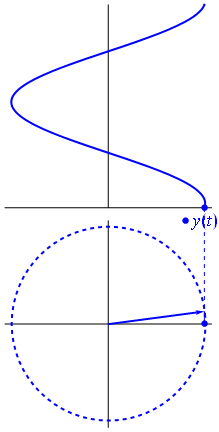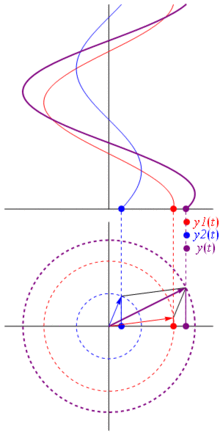Почему в цепях переменного тока синусоиды представляются в виде комплексного числа в полярной форме? Я не понимаю с физической точки зрения, почему вообще существует воображаемая часть. Это чисто с математической точки зрения, чтобы облегчить анализ цепей?
Зачем использовать комплексные числа для представления амплитуды и фазы переменного тока
Ответы:
Цитата: «Это чисто с математической точки зрения, чтобы облегчить анализ цепей?»
Я не уверен, что на эту часть вопроса уже был дан достаточный ответ. Поэтому: да - использование сложной математики для описания синусоидальных сигналов не имеет прямого физического значения. Это просто, чтобы «сделать анализ легче».
As an example: Introducing Euler`s famous formula for sinus signals into the Fourier series leads to negative frequencies (symmetrical to positive frequencies). Hence, the question arises: Do negative frequencies exist in reality? The answer is NO! It is just a helpful mathematical tool.
Actually the motivation is quite simple.
When you have a linear circuit and you stimulate it with only one frequency, wherever you will look you will always find that very same frequency, only the amplitude and the phase of the wave you measure change.
What you do then is say well let's forget of frequency, if I keep track of amplitude and phase of voltages and/or currents around the circuit it will be more than enough. But how can you do that? Isn't there any mathematical tool that allows you to keep track of amplitude and phase? Yeah, you've got it: vectors. A vector has an amplitude, that is its length, and a phase, that is the angle it forms with the x axis, ccw direction is positive.
Now you can object ok vectors are cool, but isn't anything cooler? And why do we need to use the imaginary unit?
The answer to the second question is easy: making calculations with vectors is quite a pain, a notation pain:
And that's addition alone! Well that's only a notation problem, if we choose another base of things may be better... And this base happens to exist, but requires the imaginary unit . The previous mess becomes:
Ok but what has an imaginary vector in common with a voltage? Well try to imagine the Gauss plane, the x axis is the real axis, the y axis is the imaginary one.
A voltage can be represented by a vector centered on the origin, its length being equal to the voltage value, its starting angle being equal to the phase. Now the magic trick: start rotating the vector so that its angular speed corresponds to the desired frequency:

Bam. That's what we call a phasor, and that little guy is the strongest weapon you have against tough circuits.
So why are these phasors special? That's because if you take two real voltages:

And the best thing is that all the real circuit analysis you've studied up to now keeps working with phasors and complex impedances. That is: Ohm's law holds with phasors and complex impedances, and that's great since we have a ton of tools to solve circuits that are built on Ohm's and Kirchhoff's laws, and we can still use them.
With phasors taking the derivative/integrating is also super easy: as you know, since we're speaking of sines and cosines all at the same frequency it's only a matter of phase shift, and that -surprise- is very clear if you use the complex exponential representation.
TL;DR: Sinusoids are represented as rotating vectors on the polar plane, it's pretty much like stopping time while they rotate and take a photo, i.e. calculate phase and amplitude relationships. Just check out the phasor page on wikipedia. And check this other more concise answer too.
The main thing to note is that any periodic signal (with some basic analytic restrictions that either apply in practice or apply to an arbitrary degree if not exactly) can be represented as a sum of sine and cosine signals with a frequency that is a multiple of the period of the signal.
Now once you leave the reign of direct response (like resistors), energy can be stored and retrieved. Coils store magnetic energy (apply voltage and current only starts gradually but keeps going when the voltage breaks down), capacitors store electric energy (apply current and voltage only starts gradually but keeps going when the current breaks down), masses convert force gradually into impulse, springs gradually convert impulse into force and so on.
Many forms of power are basically the square of some excitation measure. Now it turns out that the sum of the squares of the sine and cosine of the same argument is 1. A constant. So you are very well off describing the periodic conversion of energy using sines and cosines.
It turns out that algebra using sines and cosines is tenuous. If you add an imaginary term sort of representing the energy form of your periodic signal you are not interested in, and throw away whatever imaginary part remains after you are finished, the algebraic manipulations become much more straightforward at the cost of the actual variables being complex.
Say that we have a simple circuit with a voltage source connected in series with an inductive coil with inductance . Then,
What does this buy us? Well we can simply treat the coil as a resistor with value Then we could replace with the constant . In this simplified circuit we use ohm's law to find . Then in order to find the actual value of we simply multiply with and take it's real part. This can be extended to all passive components. Therefore we can model all alternating quantities with complex numbers, simplifying all calculations in the process. We can then change them back to their non-complex form whenever we need to.
I assume we agree that their are two pieces of information to represent an AC signal at any instant, amplitude and phase, whereas their is only amplitude for DC.
It is not only analysis where we need to manipulate information but also the design of circuits. Components have impedance, and effect AC signals. So when we are designing, we need to be able to calculate impedances in order to design a circuit with specific AC properties.
Complex numbers are convenient to represent and calculate both AC signals and impedance. The two dimensions, length and angle, allows us to calculate amplitude and phase together, and keep them consistent.